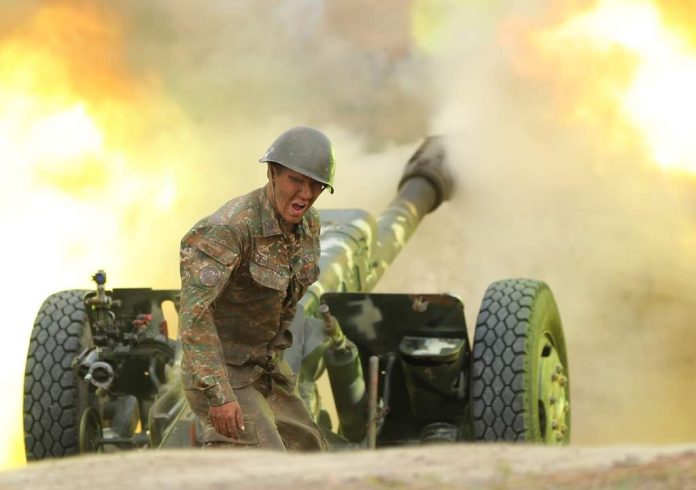No end is in sight for the fierce conflict between Armenia and Azerbaijan over the disputed border territory of Nagorno-Karabakh. The region — internationally recognized as a part of Azerbaijan but predominately populated by the Armenians — came into global limelight last month when the fresh round of clashes began with the two sides accusing each other of fomenting the trouble. The long-standing territorial dispute between the two former Soviet Union republics, is a spark neglected; it can ignite a major global crisis if left unresolved.
Claimed by both Armenia and Azerbaijan, the 4500 square kilometer region of Nagorno-Karabakh saw heavy fighting breaking out on Sep. 27. About five hundred solidiers and the civilians on both sides lost their lives. The UN secretary-General Antonio Guterres, the UN Security Council and the countries like Russia, Italy and the United States — all have called for an end to the hostilities and the settlement of the conflict through negotiations. But the two warring sides, having rejected pressure to engage in talks, have continued to fight. That has escalated tensions and led to the use of longer range artillery and other heavy weapons; the clash had started with cross-border shelling. The ongoing tensions follow a series of cross-border clashes in July this year, leading to the death of an Azerbaijani general and about twenty people.
It was in the 1920s that the Soviet government set up the Nagorno-Karabakh Autonomous Region (NKAR) — with about 95 percent population comprising of ethnic Armenians — inside the borders of Azerbaijan. And in accordance with Bolshevik rule, the fightings between the two countries were kept on hold but the grip of the Soviet Union over the two countries began to lose at the end of the1980s; in 1988, the legislature of the autonomous region passed a resolution, pledging to join Armenia, its location in Azerbaijan notwithstanding. In 1991, the NKAR decleared independence from the Soviet Union, the decision for which it received full military support from Armenia.
Following this development, war ensued between the two countries over the region. The war resulted in around 30,000 causalities and thousands of refugees. By 1993 Armenia controlled the autonomous region while occupying about one-fifth of the surrounding Azerbaijani territory. Though Moscow brokered a ceasefire in 1994, the war had apparently left deep psychological wounds with the Azeris and a cesspool of hatred between the largely Muslim Azerbaijan and Christian Armenia.
Inspite of the fact that the 1994 ceasefire saw the NKAR conflict frozen for about a decade, it has time and again turned violent to remind the international community that a durable solution needs to be found out. Artillery shelling and minor skirmishes between the troops of the two warring countries have led to hundreds of deaths. In 2016, the most intense fight was witnessed since the ceasefire; many were killed and wounded. A new ceasefire had followed. However, there were repeated instances of ceasefire violations, keeping the tension high.
There have been negotiations and mediation efforts, mainly by the Minsk group led by the Organization for Security and Cooperation in Europe (OSCE) to resolve the territorial conflict. The group organizes summits between the leaders of the two countries and holds individual meetings to address the dispute. But it has not achieved success though it has negotiated many ceasefires. The presidents of Azerbaijan and Armenia met in 2017 in Geneva under the Minsk group to seek a settlement of the conflict. The solution, however, continues to elude them to this day.
Tragically with no mediation effort succeeding, the ceasefire violations and the outbreak of fresh clashes appear to destabilize the region and bring in the regional powers like Turkey, Russia and Iran. Russia’s mediation efforts have failed and so have the U.S. brokered efforts ever since the recent escalation in tensions began. Russia has promised to defend Armenia under its defense pact with the latter. Turkey, sharing religious and ethnic roots with Azerbaijan, sheltering a minority community from Azerbaijan, is likely to join it. In that situation, oil and gas export to Europe and central Asia from the region will be disrupted. And the crisis could spill over to the wider region and make it a battlefield for big players like America, France, Israel , Britian.
While Russia and Turkey prioritise cooperation on many fronts, frictions between the two countries also surface occasionally; the clash over the NKAR is likely to prove another friction point between the two countries. It is in place to mention that Ankara downed a Russian warplane in its backyard and is supporting the opposite forces in Libya and Syria regardless of how Russia behaves with it.
Despite supporting the opposite forces in different arenas, Russia and Turkey have decided against confrontation and preferred dialogue to deescalate tensions. Yet analysts fear that the situation can be different this time. They opine that for Moscow, Armenia’s strategic significance is paramount and entering it could invite a terrible response from Russia. And as for Ankara, analysts believe that it will not take a strong step unless Russia takes the first step. This is a tricky situation: a miscalculation could lead to a full-blown war — the war whose repercussions could be felt the world over.
The views and opinions expressed in this article are those of the author.

Sheikh Shabir Kulgami is a Kashmiri (Indian) political commentator, analyst and columnist. He writes extensively on South Asia.


